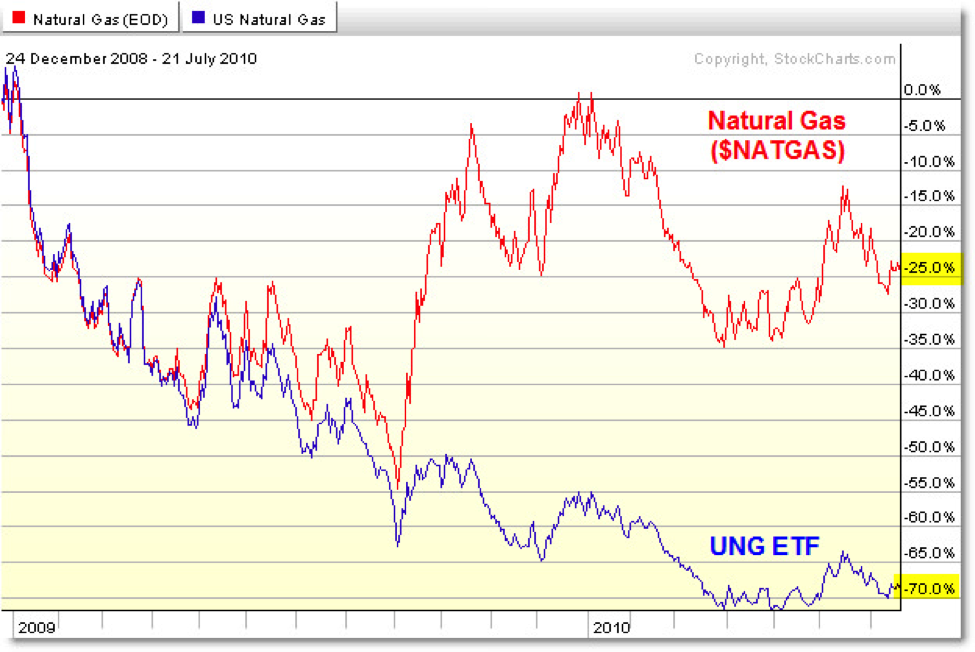Exchange-traded funds (ETF) are fairly common for beginners in investing. However, commodity ETFs are commonly more suitable for intermediate level and expert traders because of the high risks involved in these forms of investments. There have been published reports of major losses in popular commodity ETFs and as a precautionary measure, it is best to wait it out first before diving into commodity pools.
Why are investors drawn to commodity ETFs?
Compared to other forms of investments, investing in ETFs provides you with exposure in several sectors. There are many underlying investments under ETFs and one of them is commodities futures. ETFs are similar to mutual funds, but with lower maintenance costs and can be traded spontaneously like individual stocks.
Reports about major losses in Commodity ETFs
Bloomberg published a comprehensive article that talked about energy type commodity ETFs, US Crude Oil ETF (NYSE:USO) and US Natural Gas ETF (NYSE:UNG) and how contango placed negative effects on these ETFs, bringing huge losses to the investors.
What is “contango?”
Contango is a term used to describe a situation when a commodity’s future price is higher than its actual price. The futures price (forward price) is relatively higher from the spot price (current price). However, consumers still prefer to buy higher because they want to avoid the costs involved in buying commodities prior to a specific period. These costs may include storage, transportation costs and other expenses that can be incurred when the goods are purchased at a much earlier time. Simply put, people are willing to purchase futures priced higher than the spot price for convenience.
Loss in US Crude Oil ETF
In the situation of the USO fund, their projection went as expected during 2008 but when 2009 came in, the value of the ETF steadily declined due to contango. The price of crude oil went down by 20%, while the value of the fund went down much lower. By mid-2010, USO was at 55% lower than its initial value in the beginning of 2008, as shown in the chart below.

Source: ETF Daily News Website (link)
Loss in US Natural Gas ETF
Similar to the pattern of USO, the UNG fund was performing well in the beginning of 2009. But come the last quarter of 2009, the value of the ETF gave way and fell dramatically. In the chart below, you can see the huge discrepancy between the two items. The difference is almost at 50%, a massive quantifiable loss for any investor tracking this commodity.

Source: ETF Daily News Website (link)
How can an investor formulate a contingency plan against huge risks?
The best way any trader can protect himself from suffering from big losses is to stay updated with the trends. This further emphasizes the importance of having an in-depth knowledge of methods to counterbalance losses in one’s portfolio. Traders with a more diversified portfolio or those who invest in more than one investment category can withstand losses better. Why? Because other forms of investment tend to perform opposite each other. Yes, you may lose some, but eventually gain some too.
Having a deeper understanding of stock market investing concepts can be acquired from trading courses. By investing in educating yourself first, you will have access to a wealth of information from highly-experienced investment mentors who could effectively teach you the most effective tactics involved in investment risk management. Moreover, you will be provided with useful materials packed with information on the basics of stock market investing as well as time-tested tips and tricks used by established investment experts.
Stock Market Investing for Beginners
If you are new in the field of stock market investing, having a good foundational knowledge of terminologies and processes is crucial to starting the right way. We have created a FREE eBook packed with essential tips specifically for those who are new to the industry. Grab your copy here today: riskrewardreturn.com
If you enjoyed this post and want to read it later, feel free to pin this image for reference:

